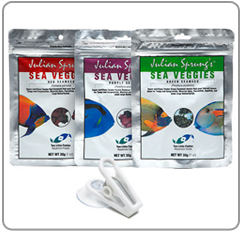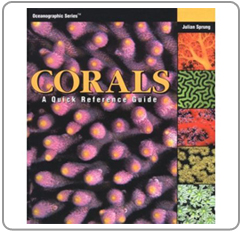|
Julian Sprung on Herbivorous Foods
Herbivorous Foods and Marine Aquarium-Keeping 
Julian Sprung’s name is synonymous with the marine aquarium hobby for many aquarists. Having grown up in Florida with a love of marine life, Julian attended the University of Florida where he studied zoology and earned a Bachelor of Science Degree. He quickly became a well-known and well-respected author, photographer and lecturer.
Julian authored the column "Reef Notes" in Freshwater and Marine Aquarium Magazine (FAMA) from 1988-2006, and he has authored many articles in other publications including Advanced Aquarist Online, Aquarium Frontiers, Practical Fishkeeping, and Tropical Fish Hobbyist, to name but a few.
In 1991, Julian, along with fellow marine aquarium enthusiast Daniel Ramirez, co-founded the company Two Little Fishies to produce the video entitled "An introduction to the Hobby of Reef Keeping,” which Julian wrote and narrated. Julian's books include The Reef Aquarium (volumes one, two and three), which he co-authored with J. Charles Delbeek, Reef Notes Revisited and Revised (volumes one, two, three, and four), Corals: A Quick Reference Guide (with approximately 700 of his own photographs), Invertebrates: A Quick Reference Guide, and Algae: A Problem Solver Guide.
Based in part on the success of Two Little Fishies herbivorous fish food known as Sea Veggies, we thought it appropriate to ask Julian to speak with Blue Zoo News in conjunction with our issue focused on herbivorous fishes.
BZN: Thank you so much for sitting down with Blue Zoo News and sharing some of your thoughts on herbivorous fishes and aquarium-keeping in general. We'd like to begin by asking you when you first became interested in marine aquaria.
JS: I was introduced to the marine aquarium hobby by my brother Elliot, who showed me his aquariums kept at a neighbor’s house when I was 4 years old (in 1970). Later my parents allowed him to have aquariums in our home. There was this reasonable concern they had with saltwater and corrosion! By the time I was old enough to have a tank of my own (at 12) I had already been responsible for maintaining another one in my father's office for a year or so, and had been caring for numerous buckets of marine life for years in a neighbor's backyard.
We lived on a residential island on Biscayne Bay in Miami Beach. Seawater and marine life were plentiful. I think that a visit to the Florida Marine Aquarium Society show at Miami's Museum of Science in 1973 was very influential as well. This was where I saw blue ribbon eels, clownfish, royal grammas, and hepatus tangs for the first time. Elliot already had an aquarium at home by then, and we collected fish and invertebrates as well during trips to the Bahamas, Cozumel, and Jamaica.
BZN: What is your favorite marine herbivorous aquarium fish and why?
JS: Boy, it is hard for me to pick a favorite fish of any kind—I love all fish! Mandarins, which aren't herbivores, are up there if I had to choose a favorite fish, but in the herbivore category I'd have to say that a few come to mind. One is the starry blenny (Salarias ramosus). It's not pretty, but is very charming and an excellent grazer. Of the surgeonfishes I particularly like the Indian Ocean or Red Sea variety of the sailfin tang, (Zebrasoma desjardinii).
BZN: In your opinion, should aquarists employ herbivorous fishes as algae control in their aquaria, or should they rely more on invertebrates for algae control? What are some of the pros and cons of using fishes for algae control in a marine aquarium?
JS: A combination is always best. The herbivores hit different areas, and mixing the grazing types affords the best solution to controlling algae in the display aquarium. The pros of using fish is that the fish are beautiful and great to watch. The only cons I can think of are that some herbivores may nip at corals occasionally, and some (Acanthurus spp. in particular, and Paracanthurus to a lesser extent) are very prone to Cryptocaryon and Amyloodinium infections.
BZA: We've heard you say that most flake food is not so nutritious, especially for herbivores. Will you elaborate a bit?
I've never said such a thing. What I have said is that the fillers in many flake foods aren't so nutritious. SeaVeggies flakes are not made with binders (also known as fillers). I consider flake foods to be good staple diets even though they have these fillers. SeaVeggies are advantageous because they hold on to the nutritional value in water much better.
BZA: I see. Our mistake. Tell us a little more about what the aquarist should know regarding the nutritional value of flake foods.
JS: Flake foods are indeed nutritious, and are a good staple for herbivores. This is particularly true of the Spirulina enhanced varieties, but even the high fish protein flakes are suitable for herbivores, though it is best if some seaweed is also offered to them each week. Flake foods can leach much of their nutritional content within a short while after they hit the water, so it is important not to put too much in the water at once. If you feed just what the fishes will eat within a few seconds, and then offer more, you have the ideal situation.
Flake foods should be fed into a feeding point (floating ring). Otherwise they may be drawn over the overflow drain. Flake foods should be stored in the refrigerator after opening—not in the aquarium stand or hood! The humidity and temperature around the aquarium rapidly destroys their nutritional value. Lastly, you should buy what will be used in a few months. Flake food in a can that has been open for a year and left at room temperature should be discarded.
Two Little Fishies' SeaVeggies are available in a flake form. They hold their nutritional value in water better than typical flake foods do because they are not made as a mixture held together with binders. They are just dried seaweeds cut to flake sized pieces.

BZA: Is there a nutritional difference between Porphyra umbilicalis, Porphyra yezoensis and Palmaria palmata? If so, what is it, and how does knowing this help the marine aquarist?
JS: The algae you mentioned are the purple, green and red varieties of Two Little Fishies' SeaVeggies. They have different contents of protein, fiber and fat, but this is not of much consequence to the marine aquarist. Some fishes prefer one variety over another while others eat all of them. There are significant differences in the texture and taste that affect the preferences of different fishes. It is not possible to predict which variety a particular type of fish will prefer. However, it is predictable that if a fish prefers one variety, switching to another variety is often difficult. Fish develop habitual preferences, unlike dogs, which prefer anything new.
BZA: Are flakes or strips better for feeding marine herbivorous aquarium fishes?
JS: Most aquarists prefer the whole plant strips secured with a veggie clip. Probably this is because flakes tend to get pulled into the overflow. If aquarists used a feeding point this would not be a problem. The veggie clip does provide a nice point for feeding as well, and it is interesting to watch fish grazing competitively at the clip. When the flakes are put in at a floating feeding point, they can then sink and be scattered by the currents to feed all sorts of fishes. It is interesting to see how not just herbivores but carnivorous fishes eat them. There is no nutritional difference between the SeaVeggies flakes and strips. An advantage of the Mixed Flakes is that you get 3 varieties in one product.
BZA: There has been a lot of talk recently about the importance of keeping herbivorous fishes on the reef instead of in the aquarium or in our stomachs. Do you think the marine ornamental industry is harming reefs by popularizing herbivores such as the yellow tang?
JS: No, I don't think the marine ornamental industry is harming reefs by popularizing herbivores, but it has been shown that harvest of them from the regions where they are collected reduces the total numbers—duh! The same could be said of any fish harvesting fishery.
The recovery time is rapid for marine ornamental herbivores, and the industry can be operated in a sustainable fashion. It is most important to emphasize the husbandry methods and quality care by the collectors, exporters, and importers to minimize losses, which reduces the waste of the renewable resource.
I would like to add that while I don’t believe the harvest of herbivorous fishes is harming reefs, nor populations of these fishes, the harvest of herbivorous snails can have significant localized impact on their populations. I believe that farming of herbivorous snails is the most practical sustainable option for the aquarium hobby.
BZA: We have heard you have some experience with aquaculture. We are interested in learning more about aquaculture/mariculture, especially for 1) increasing the number of tank-bred species available to the marine hobbyist and 2) sustainable, herbivore-oriented, small industry, small enterprise aquaculture for food. Do you have any comments or thoughts on the current state of the mariculture industry?
JS: I have a little first-hand experience with aquaculture, yes, but it is not something that I do as a profession. I think the mariculture industry is growing nicely. Every year I get more inquiries about coral, clam, and fish farming from young entrepreneurs wanting to set up facilities all over the world. The only thing I can say is that the supply of farm-raised marine life does not come anywhere close to meeting the demand—a good situation for the farmers. However, farming of perishable creatures is always a risky business! Food fish farming has its supporters and detractors. There is much that could be done to improve the techniques to make the food farming industry more environmentally friendly.

BZA: Tell us a little about your company, Two Little Fishies—its mission, how it came into being and your vision for the company's future.
JS: Two Little Fishies was formed in 1991 when Daniel Ramirez contacted me in Miami about producing an educational video about reef keeping. He had originally contacted Terry Siegel, now the editor of Advanced Aquarist Online, who he knew from Pratt Institute where Terry was a professor and Danny had been a student. Both were avid marine aquarium keepers, and were hooked on the relatively new hobby of reef aquarium keeping. Terry, who still lived in New York, was not able to work on the video at that time, but by chance I had recently moved back to Miami from Alexandria Virginia. I had moved to Alexandria after graduating from the University of Florida to work as staff biologist for a young company, Sea Kleer Reefs, later J.P. Burleson, Inc.
During the two years there I made many friends in the aquarium industry, and I developed a little recognition in the aquarium field due to my monthly column, “Reef Notes” in FAMA Magazine. Danny saw me give a lecture for the Florida Marine Aquarium Society, and thought I could take the subject matter and work it into a video, which is what we did. It was our first product and was truly an amazing success—the timing was just right.
Not long afterwards we began work with Charles Delbeek on the book that would eventually become The Reef Aquarium Volume One, released in 1994, again just at the right time for the aquarium hobby. By that time we already had begun manufacturing and importing aquarium products. Two Little Fishies now publishes and distributes its popular aquarium reference books in English, German, French, Italian, and Japanese, under the d.b.a. Ricordea Publishing.
Our company mission is to manufacture and distribute products of the finest quality that are simple to use, elegant, practical, and useful. By providing these solutions and publishing the latest information about how to build successful and beautiful aquariums, we enhance everyone’s enjoyment of their aquatic hobby and build a following of happy successful customers.
Two Little Fishies’ product lines includes water conditioners, filter media, underwater bonding compounds, and specialty foods for fish and invertebrates, beautifully engineered filters, floating feed clips, window-cleaning devices, and plastic fittings used for air and water plumbing.
BZA: In addition to all the products Two Little Fishies currently sells, is there anything new and exciting on the horizon that you could share with Blue Zoo News readers?
JS: Yes. Two Little Fishies will soon offer bottled natural seawater, select sands and gravels, media for calcium reactors, and several new patent-pending products, including the only user-calibrated hydrometer.
BZA: Would you briefly describe for us your favorite aquarium set-up in terms of equipment, aquascaping and livestock?
Hmmmm. Are you serious?! Brief descriptions for such things do not exist. I don’t have a favorite aquarium, really. I like many aquariums! Let me be generic here please, as it will offer a range of what interests me, and I hope will be of interest to the readers—
I have several of my own, including some reef and freshwater displays. I prefer rimless open top aquariums, with flat-polished glass and a low water level. Acrylic tanks are nice but I prefer glass for reef aquariums.
Some types of displays that captivate me include (but not all in the same tank!)
- fluorescent corals
- seagrass beds and mangroves
- schooling fishes
- gorgonians with wave motion
- seahorses, pipefish, shrimpfish, and mandarinfish together
- sand-dwelling fishes such as jawfish, garden eels, and Pholidichthys
- any well done nano display, especially with zoanthids or corallimorphs.
Freshwater planted tanks with schools of small fishes and fascinating little shrimps are also up their on my favorite types of displays. I’ve also seen magnificent giant planted tanks with freshwater puffers or large altum angelfish that are so pretty they can convert the most stubborn old salt to freshwater. Heck, I didn’t even mention discus or some of the really esoteric freshwater fishes, of which there are many.
With regard to equipment, I've always been a proponent of less is more, but there are still many useful pieces of equipment to facilitate maintenance. One of my favorite newer pieces of equipment is dimmable lighting. The effect is wonderful because it is sensed not just visually but also physically and emotionally. You “feel” it. A very cool experience.
BZA: Well I imagine that will keep our readers busy for a lifetime. Thank you so much Julian for taking the time to speak with us. We would welcome your input anytime.
Published 3 June 2008. © Blue Zoo Aquatics
|